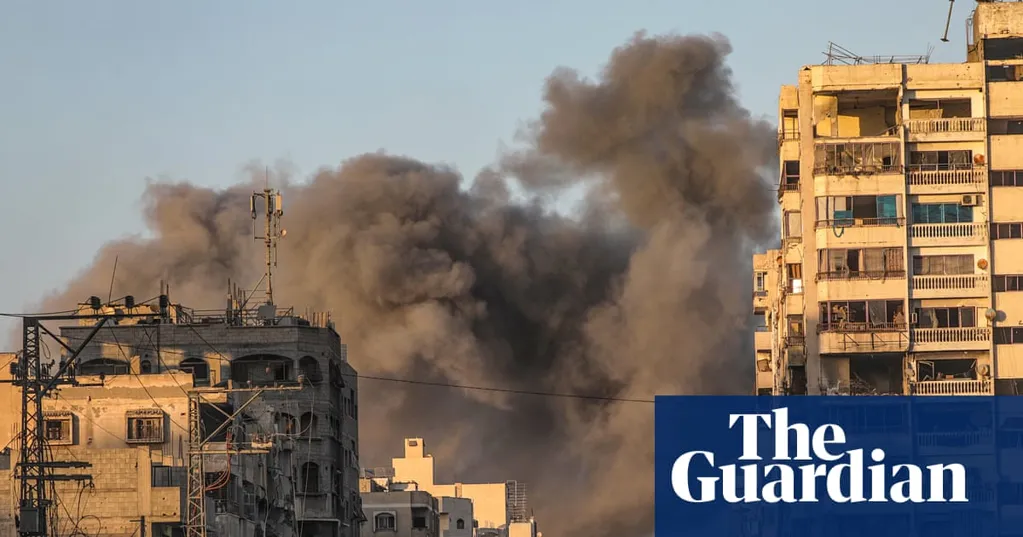Israeli military says aid infrastructure could be targeted after order to 'all Gaza residents and inhabitants' to leave
Humanitarian workers in northern Gaza have been repeatedly warned by the Israeli military that only hospitals will be considered protected sites and all other aid infrastructure could be targeted.
In messages and conversations with aid workers in recent days seen by the Guardian, the Israel Defense Forces (IDF) said an order to "all Gaza residents and inhabitants" to evacuate Gaza City, the biggest urban centre in the territory, applied "to all humanitarian locations [there], except hospitals" and warned that "to defeat Hamas [Israeli troops] will operate ... with great force".
On Friday, the IDF said it had expanded operations in Gaza City and bombarded "Hamas infrastructure". Between a quarter and half a million of the city's estimated 1 million inhabitants have already fled but some displaced Palestinians traumatised by the advance said they had no means to leave.
Vehicles for the gruelling six- to eight-hour journey south can now cost as much as $2,000 (£1,500).
"The situation is really bad. All night long, the tank was firing shells," said Toufic Abu Mouawad, who left a camp for the displaced on the city's outskirts but had nowhere else to go. "I want to flee with the boys, the girls, the children. This is the situation that we are living in. It is a very tragic situation."
Israeli officials said they were preparing a "humanitarian zone" in the overcrowded, underdeveloped al-Mawasi coastal area in southern Gaza by building new aid distribution sites nearby, supplying electricity to desalination plants, providing some water and allowing in more aid.
Most of northern Gaza is already emptied of civilian and in ruins. If Israeli troops take over Gaza City, the entire 2.1 million population of the devastated territory will be confined to a small enclave in the south. Currently, all these checkpoints through which goods and people can enter Gaza are in the south, with the Zikim checkpoint which served the north closed since last week.
Much of the north lies in ruins after 23 months of conflict and a campaign of systematic destruction by Israeli forces that has intensified in recent months. Little of Gaza City is expected to escape the new Israeli offensive.
"People might want to go back but what would they go back to? It is very difficult to imagine how it could work," said one senior aid official working in Gaza. "There is an emotional attachment but there is a real question mark over how you would live."
The Israeli army has constructed two new aid distribution hubs close to Gaza's southern border with Egypt, which will be used by the controversial Gaza Humanitarian Foundation (GHF), an opaque US and Israel-backed private organisation that started work in May. The GHF has been running five such sites where food boxes were handed out on a first come first served basis, but three are thought to have been shut.
In an email, GHF said that 12 truckloads of food had been distributed on Wednesday at two existing sites in the far south of Gaza , one in the ruins of Rafah and another in Khan Younis. The new sites are close to the Egyptian border.
The main entry point from Israel serving the north of Gaza has been shut since last week. Aid convoys from the south face massive logistic difficulties and are often refused permission by the IDF. Last month a famine was declared in Gaza City by UN-backed experts.
The IDF has said it is expanding the Kissufim crossing to allow more aid to reach the designated "humanitarian zone" in al-Mawasi. This too will serve the south of Gaza only, aid workers said.
All aid into Gaza was blocked by Israel between March and May, and only very minimal amounts were allowed to enter until recent weeks. About 250 trucks were now bringing food and other essentials into Gaza daily but such quantities were only a fraction of what was needed, and tight restrictions remained in place, experts said.
"It is better no doubt than in June and July but not the kind of better that will move the needle in any major way on the famine, for children dying of malnutrition or in terms of the day to day life of the average Gazan," said Katy Crosby, Mercy Corps senior director of policy and advocacy.
A high proportion of trucks are commercially operated and are bringing in items such as soft drinks and snacks that are not nutritious but expensive.
Many Israeli observers and commentators believe the real motives for the new offensive into Gaza City are political: to keep Israel in a state of war so as to fend off early elections in which Benjamin Netanyahu's coalition could be unseated - and to ensure that north Gaza is made uninhabitable, which would please the Israeli prime minister's far right allies.
It could also encourage Palestinians to leave Gaza permanently.
Cogat, the Israeli defence ministry body that administers access to Gaza, on Wednesday issued advice to Palestinians in the territory who wanted to leave, while Bezalel Smotrich, Israel's far-right finance minister, described Gaza as a "real-estate bonanza", according to Hebrew media last week.
